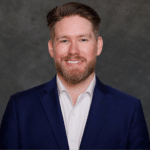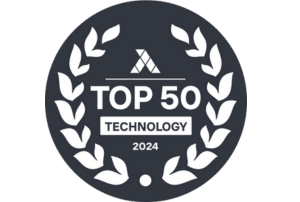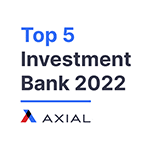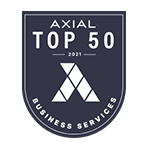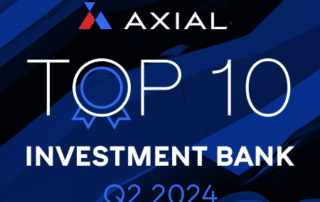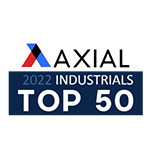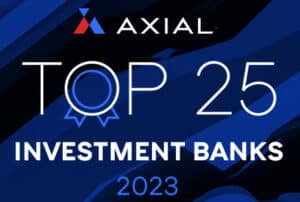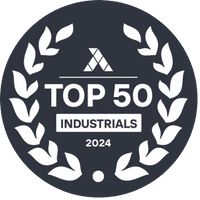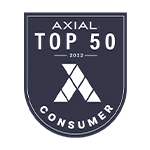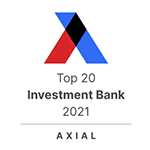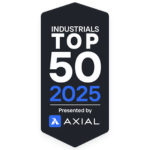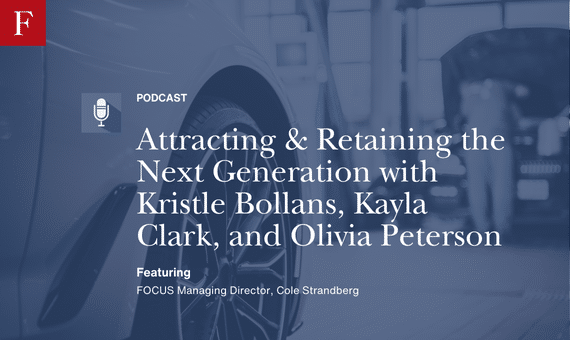
Attracting & Retaining the Next Generation with Kristle Bollans, Kayla Clark, and Olivia Peterson
In this episode, Cole Strandberg chats with industry leaders, Kristle Bollans (National Sales Director at CSN Collision), Olivia Peterson (An Instructor Trainee with I-CAR), and Kayla Clark (SVP of Business Development at Classic Collision). They discuss how to attract, onboard, and retain top talent in collision repair.
They explore what shops can do to create a more welcoming and supportive work environment, how to modernize hiring and training practices, and why it’s critical to move away from outdated mentalities like “earning your stripes” in ways that discourage new talent. And of course, they talk about how to make the industry a great place to work for women, and what shop owners can do to create a more inclusive and supportive workplace.
Cole Strandberg: Looking forward to a super fun, super different conversation here today. Almost more of a panel discussion than maybe a traditional one on one podcast. Before we dive in, I told the audience a little bit about each of you at the top of the show but would love your own words. Kayla, let’s start with you. Who are you?
Kayla Clark: Hi, I am Kayla Williams Clark. I am the SVP of Business Development at Classic Collision. A little bit about me is I am based out of Denver, Colorado and have spent about 15 years in the MSO space. I actually started with Enterprise to rent a car back in the day. So that’s how I got into the industry and looking forward to the conversation today. So thank you.
Cole Strandberg: Should be awesome. I think I’ve seen you for many years at different golf tournaments, I car conferences, everything. So excited to have some time with you here today. Olivia. Let me hear about you in your own words and you have some exciting updates in your career as well.
Olivia Peterson: Yes I do. Hi, I’m Olivia Peterson. I am recently from the Body Shop world. I was a body tech for about four and a half years with my apprenticeship multi time career changer. I started life as a classical musician and I did a brief stint in libraries before coming into the world of collision repair and as of last week I am assuming a new role at I Car and I am an instructor trainee for their specialty training in EV.
Cole Strandberg: And adas and we had the chance to meet in person a few weeks ago in Chicago at the AASPI show which was an absolute pleasure and you are too humble to bring it up yourself, but I believe you are an award winner of some sort as well. Talk to us about that real quick.
Olivia Peterson: Yes, right around the time that I was finishing my schooling in 2022 I participated in SkillsUSA and I won the gold medal in collision repair technology at the state level and at the national level.
Cole Strandberg: That is awesome. Very very cool. Excited to incorporate you into this conversation today. Pretty heavily as probably the most recent graduate and kind of newer entrant into the industry, but looking forward obviously extremely accomplished. Kristle, would love to hear about you in your own words.
Kristle Bollans: Yeah, absolutely. I am based out of Madison, Wisconsin. I am the National Director for CSN Collision on the the sales side of the house. I’ve been with CSN just over a year. Prior to I work for Hertz Rent a car for 21 years mainly in the collision space, so working closely with insurance carriers, MSOs, independent shops. So new to the company, not new to the industry. And yeah, I’m just really excited to be here and talk about the future of the industry and what we can do to be a part of the solution and the growth as we go forward. So thank you.
Cole Strandberg: I love it. A heck of a group here. I’m super excited and I want to start off on a topic that could end up ultimately taking up most of this conversation and rightfully so, and that is attracting the next generation of talent within the collision repair industry. And Kayla, I want to, I want to start with you, but I want to give everyone a shot. To answer this from your perspective, what are the biggest barriers to attracting young people into the collision repair industry today?
Kayla Clark: I think it’s a couple things. I have visited several schools nationally and gotten to talk to a lot of students, which has been very cool, but also very eye opening for our industry. I think getting a perspective of a 15 year old or a 17 year old is very different than our perspective after 15 years in the industry. Right. Of what we think we know about what younger generation is thinking. Two of the things that I hear most frequently is by the time they’re visiting the career fairs or you’re visiting the school, a lot of the students, there’s only one or two that for sure know they want to go into this industry. A lot of them end up in the classes or the program at this school because they didn’t know what they wanted to do as their elective. And so I feel that is a barrier getting people interested because we actually have to start younger. I think getting the people that have started into those collision programs at the younger and getting them intrigued and interested and knowledgeable about our industry is going to be the key to this. Because I think by the time they’re 17, 18, ready to graduate, there’s really only one or two kids in each of those classes in my experience that like, yes, yes, I want to get in, how do I get in? And the others are bused into a career fair because they’re told to be there and figure out what they want to do. I think the second thing is also the parents. I think a lot of parents are not adequate, adequately informed about what our industry is. They’re pushing college, they’re pushing what they hear the right path is for their child because they want the best for them. They just don’t have enough knowledge on our industry to support that and push that. And so a lot of students either find out from their instructor or if we are able to visit school. So I think you’re targeting two things. One, getting people interested in at a younger time frame in their life and two, educating the parents to want to support that career path.
Cole Strandberg: The information to the parents and the students at a young age is so important. And I think even us being in the industry for in a lot of cases, many years, there’s still a gap of information on what does a career path look like? What can you actually make in this industry? What are the options? So I think it’s A great conversation to have. Kristle, I’ll kick that question over to you as well. What are, from your perspective, the biggest barriers for our industry in attracting young talent?
Kristle Bollans: Yeah, I think a couple of things. Number one is, you know, to Kayla’s point, that maybe we’re only having one or two students that are coming out that are actually trained in collision repair. So now we’re seeing if we’re just looking at body shops, we’re looking at employees that are coming from Starbucks, that are coming from the gas station, or coming from, you know, as a hairstylist, I mean, coming from all different areas. So that means that we’re starting really at ground zero as far as training goes. And so we more than ever need to make sure that, you know, along with ICAR and, you know, those sort of training programs, they have to be really robust, but also things that are going to be retainable for this newer generation. And then I also think, you know, another barrier is, you know, Covid, certainly in all industries had an effect on employment. And, you know, we were having a technician shortage prior to the pandemic. It was amplified after. But now we’re looking at so many companies offering hybrid models and remote work. Not to say that in the collision industry, there aren’t positions that would allow for such thing. But if we’re looking at a technician or a painter that’s in the body shop, that can be a little tough to compete up against, especially, you know, if their peers are in a job where, yeah, I get to work from home or I, you know, um, so I think we have to somehow make it exciting, you know, and, and create that culture to, to get. To get employees to stick. So, yeah, I mean that, like I said, we could talk about this all day, but I think those are two of the. The big ones that I see.
Cole Strandberg: No question about it. And a couple things that we’re going to touch on that you mentioned a little bit later in the conversation, but spot on. Olivia would be very interested in your perspective on that same question. What are these barriers to attracting young folks?
Olivia Peterson: Yeah, I think one of the biggest problems is just the way that the industry is currently marketing itself. It still has this connotation of being the dirty, gross, blue collar, hard work. And I mean, in some ways it is. Don’t get me wrong, I was rarely clean when I went home from being a technician. But there’s so much more technology and science and art involved in this industry. It’s not just fixing busted cars. And I think that it would really be helpful if we just start marketing the industry differently than just this quote unquote, blue collar job that it’s always been this trade. It’s skilled, it’s artistic, it’s scientific. The technology on these things, the vehicles that we’re working on, is evolving every single day. And I think that we need to consider the type of talent pool that we’re tapping into. I know, like Kayla said, you know, usually there’s only one or two students who actually want to pursue a career in collision. But when you think about the amount of skills and the variety of things that people have to be able to do in this sort of field, and I’m usually just speaking from the technician perspective. You know, there’s so many more people that we could be reaching out to. I like to say this is the hardest job I’ve ever had. You know, the research on these things, the protocols, all the procedures, the technology is so, so advanced. And I think there are people who just don’t understand that that’s a regular part of this job and who could be really attracted to it and not just, you know, from that side, but also combining it with the hands on elements. That was another reason that I was drawn to this. I know, Kristle, you said that sometimes we’re in competition with the people who can provide remote work options, but I specifically was drawn to it because I was thrown into a remote work situation and I wanted nothing to do with it. I wanted to be back with people and I wanted to be back doing things with my hands every day. And, and this was the perfect opportunity for me. And I know that there are probably other students out there who just don’t realize that this could be such a great career for them.
Cole Strandberg: No question about it. Well put and so much to like there. And your current newly current employer, I think did a great job of this here over the last 12 to 18 months in marketing. These cool kind of newer facets of the industry where it’s a totally different ballgame than it was even just a decade ago with ADAS calibration and all the new technological innovation in the industry, it’s cooler than it ever has been. You nailed the segue for me already and I’d like to continue down this path on marketing as an industry to acquire talent. Kristle, from your perspective, how can our industry, from the macro perspective, from the I cars, the crefs, the wins of the world, how can we market ourselves as, hey, this is a great place to spend a career, right?
Kristle Bollans: Well, you know, I, I think it’s, it’s really showing the diversity back to kind of, you know, Olivia’s point of it is scientific. It is artistic. I mean, I don’t know about you. When I hear those words that, you know, gives me a little bit of a, I guess, thrill, you know, like, yeah, that, that is. Those are really fun words. Right. Rather than dirty or hard work or. Or those sort of things. Like. So I, I think that we have, you know, when you think of collision repair, you’re thinking about turning a wrench. But we really need to look at all the different career paths that we have in this industry. I mean, even just looking, you know, right here, like all of our different experience that we’ve had, the different jobs, roles and hats that we’ve worn along the way, you know, And I also think, and I think we’re doing a better job of this is, is working together collectively. So whether it is a, a craft or an I car or a WIN or, or, you know, another organization is really like linking arms and saying, okay, what are we going to do about this if we want to succeed? Because we all feel passionate about what we’re doing. So how do we work together as a community to, you know, to. To make this an, you know, attractive thing? That’s, I feel like that’s a little general, but that’s kind of, you know, what I see.
Cole Strandberg: It’s a great point when we talk about career mapping and showcasing the opportunities. There’s really not a more diverse group of career paths than represented right here. Like, nobody here has had a perfectly normal career path to land where you are, where we are. And I think it’s cool to highlight that and to showcase that the more different routes that we can amplify to the prospective new collision repair industry people, the better, the more differentiated kind of role models exist out there. Kayla, from your perspective, how can we market ourselves better to the next generation?
Kayla Clark: I think we need to evolve more in creating accessibility to more shadowing into what we do. Because I think when the students are in the career program, to Kristle’s point, they’re turning the wrench, they’re getting accessible to the I car trainings that they’re applicable for and their position of that student, you know, but I think there’s not a lot to show the robust career paths. We need to get better in creating some accessibility to showing all the different levels. Whether, you know, they’re attending a WYNN event. We try to do a lot of meetups through WIN Women Industry Network. For those not familiar with win, but attending, those hearing the different stories I think every time I attend some kind of networking meetup through CREF or ICAR or win, I’m always meeting someone of a different background and learning something and that wasn’t accessible to me. But when I started, I actually even talked to someone today on another call, pretty sure it’s like her first week in the industry. Because I didn’t know I was qualified to be in this industry. I don’t know anything about a car. Right. But there are so many different positions in our industry that people are qualified for and continue to learn, to learn other positions. And so I think creating an accessibility path to showing that is going to have to be the future to really showcase all of the community that we serve and the different roles that are offered.
Cole Strandberg: I love it. Olivia, I’m going to hit you with a couple questions here, back to back, because I think your perspective is really current and unique kind of recently having come through your entrance into the industry. And the first one is, what misconceptions before you joined the industry did you have about the industry?
Olivia Peterson: Yeah, and this is actually going to piggyback off of what Kayla and Kristle just said. And I thought that I was going to have to spend the rest of my life as a technician. And when I went into the shop and I saw some of these, you know, older people in their 60s who were still being technicians, and frankly, they were kind of broken and dispirited and it was a little disheartening. Then I realized, like, there are so many other things that I can do. You know, I don’t have to spend the rest of my life in the shop. Some people want to spend the rest of their life in the shop, and there’s nothing wrong with that. And good for them if they can survive it because it’s. It can be pretty difficult work and, you know, physically taxing. But that was. That was actually one of the reasons I was really motivated to stay in collision. Because here I was, I just came from two different careers where I really didn’t see a nice pathway. I wasn’t sure if I saw myself doing it for the next 40, whatever years of my life. And now I had the option where if I don’t like this, look at how many other different things I can do, you know, that the door is never closed. I always said, you know, this was my third career change. Like, you have to stop. Third time’s a charm. But I have all. I mean, even already, I’m, you know, four and a half years in. I’m in a different sort of role now. And I don’t. It can go in any number of different directions. And that can be, you know, the same story for anybody. And that’s really encouraging to know that there’s that flexibility there.
Cole Strandberg: It’s a good point. We talk about a career change and changing industries. The truth is there’s dozens, multiple, multiple, dozens of different career paths within this industry. And so much room for, whether it’s entrepreneurial aspirations, management, or leadership aspirations, a lot of different avenues to go. Olivia, back to you. And I’m going to give Krystal and Kayla a shot to answer this as well, but we talked about how the industry can market itself from a macro level. The I cars, the crefs, the wins, from a micro level, from a shop or an organization level. How can organizations make themselves more attractive to younger workers?
Olivia Peterson: I think they really just need to understand that the generations that are coming in, they have kind of a different mindset about work. That’s at least my interpretation of it. I mean, I’m. I’m a young millennial, I think, is what they call me. And I can already tell a difference between the way that I approach work and the way that the generation that is currently the majority in the industry, the older generation, the way that they approach their work, you know, they’re very nose to the grindstone and the hustle culture sort of thing. And I think as the generations are getting younger and even, you know, the generation below me, I’m seeing even more of a difference between how they approach work, and they’re much more interested in having that work life balance. The hustle culture is kind of a thing. In the past, we’d rather take time to do a job correctly and be proud of the sort of things that we’re doing. And if workplaces can recognize that and support that, that’s what this next generation wants. You know, we’re talking about that there is this talent shortage, and yet there isn’t a lot of shift to accommodate the way that this new generation thinks and the way what they expect a workplace to be like. So the more that we can start incorporating, you know, some more of that flexibility to make it more appealing to them, then we might have, you know, better chances of retaining these new technicians that we are in such desperate need of.
Cole Strandberg: Well said. And I want to get to retention here a little bit down the road in our conversation. It’s actually right around the corner. But before we do that, Kristle and Kayla, you both obviously work with major employers within the collision repair industry. So from your perspective, how can organizations at the micro level make themselves more attractive to younger workers? Kristle, I’ll start with you.
Kristle Bollans: Sure. I, I mentioned this before, but culture, culture is huge. And, and you know, work, when we’re talking about work, life, balance. But, but also when you’re at work having something that feels bigger than yourself or you feel connected to, I definitely see this, you know, even with, with my kids who are, you know, 15 and 11, is that connection to why I’m doing the work that I’m doing and how does that have a greater impact on those around me and the community around me. So I do think that being able to plug in, even on, you know, small levels is hugely important. You know, it’s going to make it, and we don’t, you know, I’m not saying that we have to create families at work, but it’s going to make it a lot harder to leave if you feel that connection to your workplace. But also just having that open communication of and, and listening that if you have an employee that’s not happy or not satisfied or doesn’t understand their work, instead of taking that as, you know, a criticism, really using that as an opportunity to understand of this is a really good employee, that maybe this, this job function doesn’t work for them and, and maybe we need to put them somewhere else. And I would say the other idea that I was kind of thinking of or thought is, and I lost it.
Cole Strandberg: That’ll happen. That’ll happen. I, I, I do that all the time here as our listeners will know. If you think about thought number two, I will back up. In the meantime, I’m gonna flip it to Kayla for the same questions. How, how do organizations make themselves more attractive to young workers?
Kayla Clark: Yeah, I really have to replicate the path Kristle was on too. I think two things that came to my mind about this were ownership and belonging. I think creating a sense of ownership and pride for whatever your role is in that in the shop. Right. It could be a technician, it could be an estimator, it could even be the csr. Taking care of the customer is really creating that sense of ownership that they own that part of the business. And then belonging to the bigger part of the picture, the shop, the organization, and cross training people in different roles and I think also getting them exposed to other shops. You know, especially when you have multiple shops, I think it’s great to get people introduced to other shops. They may see different types of customers, different type of vehicles, have a different, you know, setup in their shop and to share those stories, I think really creates success. And they’re belonging to something bigger than just a couple cars that came in that week or answering the phones there. Those roles are so much more important to that. And really creating that ownership and belonging makes you feel prideful of what you do and want to succeed for the bigger picture and to see that, you know, it reaches the community and things that Kristle were talking about. So I’d have to replicate that.
Cole Strandberg: Culture is a word that I think, or at least a concept that came up with each of you. And it just goes to show how hand in hand culture and the talent shortage or at least retention of talent goes together. And to that, in our pre show call, we talked about some challenges within the industry and within retention and within the mindset of younger workers. And something that that came up was sort of this, we had it tough so you should too mentality. We’re going to sort of put you through the wringer and the strongest are going to survive. That’s not how this generation works. It’s not how a lot of generations work. In fairness, do we think we’re making it unnecessarily hard for new hires? And Olivia, I want to start with you on that one.
Olivia Peterson: Absolutely. I think that honestly, that’s one of the biggest reasons that people don’t stay in the industry. Because tough skin shouldn’t have to be a job requirement. We’re here to do work, you know, and we don’t need to be bullied. We don’t need to deal with harassment and things like that. We just want to be able to fix the cars. That’s what we’re there to do or whatever. You know, our role is in there. And it really does need to shift away from this and it needs to be more supportive because I don’t think people realize that it is really just driving this next generation out. They really don’t have the tolerance for this. Again, it’s just kind of how they were brought up. You know, in the past people were, you know, the rough and tumble, thick skin, just like that. But the next generation, for better or worse, you know, are quote, unquote softer, for lack of a better, better term. And, and that’s, that’s fine, you know, that’s how they are. And we need to, like I said before, start adapting to the way that this new generation coming in expects a workplace to be. Or else they’re going to try to find another industry where they’re actually respected and where they can, you know, be comfortable in their learning environment and just go in and do their job.
Cole Strandberg: I don’t want to minimize personality and, and culture and all that stuff because as we discussed, super, super important but at a high level too. This is a supply and demand instance in, in past job cycles maybe people were fighting like crazy just to get their foot in the door of any industry and get paid. That’s not the case now. Smart, talented young people have so many, so many options. We don’t want to be good enough. We want to be the best and attract the best. And to do that we got to treat people in the right way. Kayla, what, what can organizations do to improve their onboarding process and make their workplace better for folks?
Kayla Clark: I think a huge part for me personally of why I’ve made it as long as I have is the people. There are so many great people in our industry but it’s building those relationships. And I think when you’re new, you’re not always comfortable or don’t know where to build those relationships. So I think organizations can do a couple things. I think from the recruiting standpoint, starting those relationships like I said earlier on at the schools and really staying with that relationship, not talking to the student ones. If someone seems eager to succeed and to continue to learn or halfway interested in our industry, I think it’s worth pursuing that relationship for years to come until they are ready to graduate. But I think when you onboard creating a relationship like great they came on, then what happens? You’re like good luck to you. And I think having touch points more frequently to create that relationship for the long term. Not only just with a leader, I think almost with a buddy in the company, maybe not someone in your exact location, someone else in the organization. Right. Because you may be having hardships or confused at your location and uncomfortable be like hey I, I don’t know in this instance and may not feel comfortable asking the guy in the bay next to you for that. You know, I’m firm believer in a 30 day touch point, 90 day, six month a year. And then that relationship really cultivates from there on its own to pick up the phone and call people. You know, I think allowing your teammates to go to as much training and networking as possible to cross train and get to know other people in the industry and feel comfortable to have a resource to call and ask questions. I still, I’m learning every day and I have 10 people I call on a frequent basis. I’m like hey, what do you think of this? And that’s why I stay here because I’m always learning and growing and owning and really, the people make the difference here, in my opinion. And getting out there and being able to connect your teammates with our industry is so important.
Cole Strandberg: Kristle, how about you? What can shops do to improve their onboarding process?
Kristle Bollans: Yeah, I think having really clear expectations is, is really important. I don’t know about you, but coming into, you know, a new role or, you know, do new job function and you, you know, talk to the wrong person or you follow the wrong process and then you kind of get your hand slapped and you didn’t know, you don’t know what you don’t know. So you weren’t clear of, of what the expectation is or what the boundary was. I think that a miss sometimes and especially some finding that balance of having a fun workplace or, you know, not a micromanaged workplace is that I think sometimes employers then kind of go the other side and just, you know, let things be a little less structured. So I think that that’s really important because there’s a way to be structured or explain what the boundaries or expectations are without, you know, having it feel like you’re being micromanaged manage. And I just think that helps, you know, just for, you know, just create a very healthy environment when you know exactly what you’re supposed to be doing. So yeah, I, I would think that for me, like, that’s one of the big things from the go is, you know, these, this is, these are the things in our, our values that are most important to us as a company. And these are the processes and the procedures of, of how we uphold those values. And this is why, and this is what you do to follow them.
Cole Strandberg: I love that. And another fantastic segue. You guys are just keying me up here today. And that is. And Kayla, I’ll kick this one to you first. What are some of the biggest reasons you see for new hires leaving their companies?
Kayla Clark
I think people leave because they don’t know that career path or what’s next and don’t see a lot of process to what Kristle was talking about and filling that ownership and what they do. They don’t know if they’re doing well. They don’t really know where to go next. They see people changing shops often people are rotating shops. People are coming in and out pretty frequently. Right. And to that could be nervous to people seeing that and not knowing those clear expectations, knowing the values. I think that’s why it’s so important. Back to what I said, setting up a buddy, a mentor to really make sure they’re achieving what they want to achieve. Right. And they Feel comfortable? Are they hitting their goals? What are those goals? Are they meeting satisfactory processes of the shop? Sometimes they’re not told these things. And so I think a lot of people leave because it. To Olivia’s point, it is hard to remember all these things. I still don’t know all these things. That’s why we have a network and training and all these things that are continued. I think another big piece that people leave is because they aren’t feeling like they’re getting continuous training and involvement in the shop. So I think really supporting that and making sure they have all those resources to continue to elevate themselves in the repairs that they’re operating on is super important.
Cole Strandberg: The employer employee relationship has to be symbiotic. Right. And an employer expects an employee to provide and perform. An employee has the same expectations. If I’m not getting good feedback, if I’m not being challenged, if I’m not being given opportunities to grow and expand my abilities, what am I doing here? I think that’s a great point, Olivia, same question. How or what are some of the biggest reasons, rather, employees leave, and what can shops do to prevent that from happening?
Olivia Peterson: Yeah. Speaking from the perspective of a newer technician, we kind of alluded to this, and I feel like there are kind of two sides to this coin. There’s either that people are getting challenged too hard, too soon, or they’re in this kind of gray area where it’s like, when am I done being an apprentice? And I can speak personally. It’s kind of a really awkward situation to be in because, you know, you graduated your apprenticeship, you’ve done a major repair, maybe one, possibly two times each. You’re definitely not a master at it. I don’t know if you’re ever really a master at anything in this industry, to be honest, because it’s always evolving. But it takes a long time. There’s a learning curve and people usually throw this, like, five year concept. Give it five years and, you know, you’ll. You’ll be better with your. With your pacing, you’ll be better with your skills, you’ll be more confident. Again, just an arbitrary number that gets tossed around. But something that can be difficult for that new technician is feeling like they’re just a perpetual student, which we are all perpetual students, you know, at the macro level because we’re always learning. But it’s, it’s the, the connotation associated with being kind of like the low man on the totem pole student that is a difficult thing for us to overcome. And then, like I said, there’s that opposite side of the coin where sometimes, you know, we’re just starting out and there is a world of difference between being an apprentice, you know, with a guided mentor who’s sometimes holding your hand, sometimes, you know, just there to save you when you’re struggling and then when you go on your own and you have to learn how to do everything they were doing on your own, it is, it’s a completely different world. I was blindsided when it happened to me. Just, you know, the same things I used to be able to do with my eyes closed. Pretty much just knowing there was someone there, having to do them unguided and also having to manage all these different cars and stuff, it was, it was a lot to handle. And I think we really need to have more respect for, you know, what the new technician is actually going through. Having those guide points like we’ve been talking about those, those check ins, those meetings, making sure that they have that support system and just knowing that there is some sort of progression expected of them, that they’re not going to be thrown a frame rail their second month on the job because they’re still just trying to figure out how to be a technician on their own, but they’re not going to be doing bumpers for the next four years. You know, at what point should I be able to do what sorts of repairs out of my apprenticeship? Because that was, that was just one go, that was just the basics. Now I get to refine it and the more we can start clarifying some of that, I think that that will keep a lot more new technicians in. And one other thing that I think is a big problem is the transparency that we need to have about earnings. There’s a big conversation that we, you know, as a, as a technician, you can earn six figures and I feel like we get stuck on that without being upfront about how long it can take to actually reach the point of earning six figures figures. And when people are new to the industry and are not earning that, you know, as quickly as they thought it was, as quickly it was being sold to them, they feel either A, I’m doing something wrong or maybe I’m not cut out for this, or B, the people around me who are earning six figures, they’re going a lot faster. Maybe I should start cutting some corners and I’ll start earning six figures too, something like that. And that’s a terrible road. We don’t want to go down there either. So we need to be a lot more transparent about. Yes, you can make six figures, six figures in this industry. But you got to be willing to put in the work and it’s not going to happen immediately.
Cole Strandberg: Well said. I gosh, knock that one out of the park, all of you. I think that gives the industry a lot to think about in, in terms of how do we change. It’s not a this generation doesn’t have it problem. It’s a we are not making ourselves a good enough place to work just yet. But with people like all three of you out here kind of preaching this and helping the industry know what the fight is that we need to fight is tremendously helpful in our pre show call. I apologize, I forget who of you said this, but there was a line along the lines of I hope eventually we’re not talking about women in industry, we’re just talking about people in the industry and we hate that we have to differentiate this right now. But that is reality and, and I do believe and hope we get there one day. But I do want to talk about creating that workplace that attracts and retain women in the collision repair industry. Olivia, you and I met back in February at the AASPI conference in Chicago. I had the good fortune of being on a panel about the talent shortage and Mike Anderson teed up a question and he actually combined two groups of people that I thought was very interesting and how to attract those groups and that was women and military obviously here I want to focus more on the women’s side of the conversation. But Kristle, I want to start with you here. What are some of the biggest challenges that women in collision repair face?
Kristle Bollans: Well, I think number one we can circle all the way to the beginning as far as education that women can do this work, that women are valued in this work and women can excel in this work. So I think that’s coming from the beginning. High school, middle school, you know, get getting it into students forefront that and women or girls and that, that this is a, a path for them as well. That this isn’t just boys work. I think that certainly is, is a large one. And then you know I, I just think in general that a lot of times women are just expected to if, if we are in this line of work or we’re in this industry that we are just expected to tolerate or go along with some of the things that make us feel uncomfortable and if we mention that or, or you know, speak up of hey that’s not, you know, that that’s just not something that makes, makes me feel good in this situation. We have to think about the repercussions of that. And. And, you know, what our reputation or what a person might be thinking of us because we aren’t, you know, going with the flow or just, you know, laughing at the jokes or, you know, kind of going along with that. That’s certainly. That’s a tough one. That’s a tough one. Is. Is being able to find your voice.
Cole Strandberg: Kayla, how about you?
Kayla Clark: From your perspective, I would have to second everything Kristle said. I think it’s just the notion of being informed of what’s out there as far as the workplace. And I don’t want to say I think it goes beyond supporting. I think there’s a lot of people that are supportive of women in the workplace. Workplace. But I think fostering an environment beyond supporting, you know, showing women in leadership roles, I think is super important. I think promotions of women and accolading that throughout your company to show like we can do it just as much as not just the boys or the boys club. I think some people think it’s like the good old boy club and there’s a lot of talented women out there. There’s a lot of. Olivia called it an art. I think women have such attention to detail. They bring such art and different thought process. The cars are evolving. And I think women are bringing different perspective to what training and art and science go into that. But that needs to be amplified out there for the public to see. Because I do think just the notion. I mean, I’ve gone on Reddit to see what people say about our industry, and there’s nothing really about females on there. I mean, it’s all the guys talking back and forth, just like a guy’s industry. And so I think really amplifying that out for the public to see. Of all the women in different roles that they hold, I mean, Olivia had two different backgrounds, right? Her just even hearing her starts like, oh, that’s so cool. She came in and after having two different careers and going into being a technician, and that’s not even what people think women are doing, right? They’re saying all these other fields out there, but we can do it. And I think really getting the market out there to show all the different roles and seeing that there are a lot of women in leadership in different technician roles, estimating roles out there.
Cole Strandberg: Some great points there. We have three incredible stories of three incredibly powerful women in the industry right here. And shouting more of those stories from the rooftops is only going to be a benefit. The other piece, too, you mentioned being supportive of women in the workplace versus actually doing what it takes to foster a real supportive environment for women in the workplace. It’s two very different levels of. Of support, if you will. And I think that’s a great distinction. Olivia, I’d give you the same question as well.
Olivia Peterson: Yeah, and I’m going to go right off of that support comment and say that if you are going to say that you are a workplace that welcomes women, you need to be ready for them before they get there. One of the most difficult things for women sometimes is showing up in a shop, and next thing is, oh, we have a woman here. Oh, wait, we don’t have a women’s locker room. Oh, we don’t have a women’s bathroom. Okay, well, we’ll make that. But what that does is it kind of alienates her. And the other people in the shop see that. And sometimes it’s interpreted that she’s somehow getting special treatment when the reality is she’s just getting the exact thing that the men have, things that she, you know, is also entitled to, like women’s uniforms. Excuse me, women’s uniforms. And we need to make sure that we have a welcoming culture established before she even shows up. So she’s not just walking into, you know, whatever has been happening in the shop for some time. If. If you know, that culture of the quote, unquote, boys will be boys sort of thing is perpetuated, which I hate to say that because I don’t like throwing blanket terms over anybody, but we need to be ready for her before she shows up, because if she feels more alienated by you taking the steps too late, she’s not going to stay around. Another thing that we need to think about is why you’re hiring a woman in the first place. Are you hiring her just because you think she’s going to look good on your company website? Are you hiring her because you are working towards your diversity efforts, but really you’re just checking a box? Or are you genuinely invested in what she has to contribute? Seeing her grow, knowing that she brings different perspectives than people who have, you know, maybe they have typically been working for you and, you know, do you value that? Do you just want her there because you think having a chick in the back of the shop is going to make your men work harder? Or do you want to create a different atmosphere back there? You really need to think about why you’re hiring her and do it for the right reasons. Or frankly, don’t do it because it can, you know, drive a woman out of the industry after enough, you know, situations where she’s just the diversity tire or she’s, you know, like a zoo animal. Everyone’s just standing around watching her because they’ve never seen a woman do it before. You know, treat her as a technician again, from the perspective I speak from and, you know, give her the respect that she deserves and make sure that you’re giving her again back to the support that she needs and actually give it. Don’t just say that you’re giving it. Be there for her. It is a very difficult situation for us to be in, being so much in the minority and we, we need all the help we can get, but we really want to be here and we really want to do it.
Cole Strandberg: Man, I, I so appreciate each of Yalls perspective on that. I think it’s tremendously valuable for business owners and industry leaders to hear the Rubber meets the road actionable stuff. It’s a important initiative for the future for a multitude of reasons. But it all goes back to at the end of the day, as we zoom out of how do we address this technician shortage and you certainly don’t want to alienate 50% of the national workforce that at a bare minimum, that’s what we need to be talking about, zooming back out to the technician shortage. Rather. I want to ask each of you to pull out your crystal ball and tell me where you think we’re going to be five years from now as it comes to hiring and retention. What do we want to see there? Kayla, I’ll start with you.
Kayla Clark: I think if we continue on the path we’re on now, we’ll be in a worse situation than we are now. I think what we’re doing today, in my opinion, I’m sure there’ll be altering opinions to this, but is not working. I think we need to come together as the industry community that we are and really advocate for all of us. This is for the sake of all of our businesses. Right. I think when you’re throwing out a dollar more here and there and people are hopping across the road, it’s not creating an atmosphere for people to grow, be conducive and learn and be part of the team. So I think there has to be a heavy shift in the retention in the way. I think Olivia nailed it. People are expecting different than they did five years ago, before the pandemic, before they did 10 years ago when a lot of these technicians got into the industry. They’re wanting different expectations. Right. And I think we’re going to have to come together as united front in this industry. Whether you’re a supplier or a shop or rental car facility. We all have to advocate together to really support the same message of getting people in and making sure people understand they’re supported, they’re trained. There’s different, there’s a robust role in creating those relationships at a young age. Age to get people interested in even coming into this industry. Because I think we’re already too far behind of who’s interested in coming into our industry.
Cole Strandberg: The challenge with an issue as big as the technician shortage is kind of. It’s twofold. One, we go to events like AASPI or the ICAR National Conference and we’re all fired up about it and then we leave and go home and then business gets in the way and it sort of might take a back seat. How do we keep that energy going? Secondarily, it’s a huge task. It’s tempting as a small business owner or as an employee to just resign yourself to saying nothing I can do about it. And when. That could not be further from the truth, but it feels like such a big task to tackle. Kristle, how about you? Where do you see us in five years as it relates to the technician shortage?
Kristle Bollans: Yeah, I think it’s hard to really look out five years, to be honest. I mean, I think especially we’re looking at doing business plans. I think, you know, two or three, three years sometimes is, is daunting and. But I agree, we, we’ve got to make some, we’ve got to make some mind. Mindset changes. And you know, you, you said it earlier, Cole, about, you know, this isn’t, this isn’t a problem with, with, you know, the new generation coming in. It’s that we really, we need to change. And that’s, and it’s not just collision, you know, it’s its industries, you know, through throughout the country. But we have to look at what is important to this next generation coming up because something that we’re trying to hold on to so tightly is just not going to be there if we can’t have a more open mind and perspective of how things are changing. And also realizing that we have to have major investments in technology. AI, ADAS, EVs, all of these things are coming rapidly in this, this generation that’s coming up. You know, this is all they’ve ever known. And so we need to make sure that we have a solid infrastructure and technology to be prepared for all of that. And I think that if we can take those, those items there, the technology and, and all of that, and we use that in front of students and those coming into this workforce. I’ve said forever that I think EVS might actually save the collision industry from a getting a different sort of technician or employer or employee through the door because it’s more exciting, it’s more technical. And I think, you know, as we’ve talked about artistic and scientific, really understanding the differences from a biological perspective of men and women and, and why we’re different and how our brains work differently and how does that look in the workplace? Because so much of it is biological. It’s not just, you know, boys being boys, girls being girls. There’s biological differences that we excel in. And so really spending some time to really look at that sort of behavior and how we can make changes, you know, again, those are two pretty daunting, you know, things to look at, but, you know, gotta start somewhere.
Cole Strandberg: Well, for as many challenges as we face the industry lately, at least, and certainly this conversation seems to be trending toward an optimistic mindset. And I think, as you pointed out, all of these changes and advancements in technology and complexity of vehicles represent tremendous challenges to businesses, to technicians, but they also represent potentially once in a lifetime opportunity to reframe how we view this industry because it is so different, it is so exciting. Olivia, talk to me about five years into the future from your perspective. What do you expect to see? What do you want to see?
Olivia Peterson: Yeah, I think we really need to be hitting home on this, this culture aspect again. We’ve been bringing it up this entire time. Like you were just saying, this is such a fascinating industry where we’re at right now. There really has never been a better time to join, you know, with the diversity in just the number of career options that there are, with the really cool emerging technology stuff that we have, coupled with the technician shortage. We are absolutely in demand right now. And I think that the more that we can lean into that and then also make this just a better place to work. We’ve already got, you know, that core foundation of it being a cool job now. Let’s make it a cool environment too. And I think the more that we start building culture from the inside, you know, the better it’s going to be with hiring and retention. The more people are actually going to want to be in this industry. And I think that, you know, putting a greater emphasis on even the educational aspect of it, you know, with like, courses like ICAR offers, and really making sure that, you know, people for whatever career path they’re on, are really educated and really involved and see this as something greater than Just, you know, something to wake up to and pay your bills. The more that we emphasize that, the better chance we have of, you know, drawing and retaining this talent down the road.
Cole Strandberg: Everybody wins in that eventuality. The technicians win, the business owners win, the managers, everybody wins. And so I think it’s a fantastic, fantastic route to be headed toward. You’ve all been extremely generous with your time today. We’re recording this on a Monday afternoon, so I know everyone’s busy. So appreciative for that. I want to round it out with kind of one question to bring this home. One actionable insight for business owners, business leaders to take. And Olivia, I’m going to start with you. What is one piece of advice you would give to a shop owner or shop leader struggling to build that strong team?
Olivia Peterson: Clean your shop. Because when somebody comes through and sees your shop, it’s going to leave a big first impression. If you already have a clean shop, kudos to you. In my experience, clean shops tend to be a little in the minority, but really think about the image that you’re putting out there because the students are usually coming from these places where you can eat off of any surface. I mean, you shouldn’t, but it’s so spotless, you know, in these facilities that they’re learning from and they’re expecting to be able to work there as well. And it can be a bit of a harsh reality if they walk in and see 40 years of dust. I know that can be quite an undertaking to, you know, clean up the shop, but just think about what you’re putting out there and, you know, the more you can lean into that high tech side of where the industry is going and, you know, this scientific, almost laboratory type setting that we’re moving towards, the, the more the young people are going to want to be in that sort of environment.
Cole Strandberg: I love it. Kristle, how about you? One piece of advice.
Kristle Bollans: I would say define your brand. Like, who are you, you know, what, what are you about? What are you, you know, what, what are you, what are you looking for? What are your values? Would be number one, and number two is ask for help. You know, if you’re, you’re struggling with the ego at the door and ask for help, you know, reach out to others in the industry or the, you know, the body shop of the road, you know, form relationships and, and, and ask for help, ask for better, you know, what’s a better way to do things? What am I missing?
Cole Strandberg: Yeah, I love it. I love it. Kayla, to you. One piece of advice.
Kayla Clark: I think a theme of today has been culture. So I’ll take a little bit of a Jim Collins there. Here is having the right people in the right seats I think is super important. I think right now we’re grasping for people and they’re not always the right people. They’re not the people that are aligned with your values and your mission as a company. They’re not people that are following, to Kristle’s point, your brand that you want to represent. They’re just people that you’re trying to put in the seat. I think asking more questions around their authenticity, their personality and their drive to go into your shop to lead you long term would be my best advice is the most skilled person is always the right person for your shop. So, you know, we could teach a lot of skills. There’s a lot of training out there. I think having the right person in that seat makes all the difference.
Cole Strandberg: I love it. And rather than go around the horn and get contact information and where everyone can learn more about your respective employers and institutions, I’ll go ahead and include all of that in the show notes. We can link up on that afterward. But Kayla, Kristle, Olivia, thank you all so much for joining us on the Collision Vision for a fantastic conversation. Really appreciate each of you.
Listen and Follow The Collision Vision.

